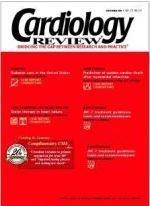TZDs: No adverse clinical effects in diabetic HF patients
TORONTO—Thiazolidinediones (TZDs) have no adverse effect on outcomes in patients with concomitant heart failure (HF) and diabetes. To the contrary, TZD use is associated with a reduction in hospitalizations and hospital days in a community setting, according to study data presented at the 8th Annual Scientific Meeting of the Heart Failure Society of America.
Fluid retention occurs in 3% to 5% of patients treated with TZDs, which increases to 10% to 15% when TZDs are used in combination with insulin. Observational studies have also suggested an increased risk of HF in diabetic patients treated with TZDs. For these reasons, the American Heart Association and American Diabetes Association have recommended against the use of TZDs in patients with New York Heart Association (NYHA) Functional Class III or IV HF. Despite these recommendations, TZD use in patients with HF is increasing, said John Golden, MD, chief of cardiology at Kaiser Permanente of the Mid-Atlantic States, Fairfax, Virginia. The use of TZDs in diabetic Medicare beneficiaries with a primary diagnosis of HF increased from 7.2% in 1998 and 1999 to 16.1% in 2000 and 2001, he noted.
The fluid retention induced by TZDs appears to be largely peripheral and not central, he said. “A retrospective analysis of TZD use in patients with left ventricular [LV] systolic dysfunction revealed no association between TZD-related fluid retention and HF severity as assessed by baseline LV size, systolic function, or functional class,” he said.
Furthermore, TZDs may have substantial cardiovascular benefits. In models of HF, pioglitazone has been shown to improve LV remodeling and function, reduce LV dilatation and hypertrophy, and improve systolic function.
Because the significant nonhypoglycemic cardiovascular effect of TZDs raises the possibility of potential clinical benefit in HF, Dr. Golden and colleagues at Kaiser Permanente analyzed their experience with TZD use in a comprehensive HF disease management program.
They studied 97 consecutive diabetic patients referred to their HF treatment program, 37% of whom were treated with TZDs (pioglitazone) and 15% of whom were treated with both TZDs and insulin. All patients were being treated with angiotensin-converting enzyme inhibitors or angiotensin receptor blockers, and 97% were treated with beta blocking agents. Clinical outcomes were assessed and compared by diabetic treatment groups at 1 year. The 1-year survival was 100% in all groups.
Nonusers and users of TZDs, excluding those patients on combination therapy, had similar improvements in ejection fraction, “but all-cause hospitalizations, HF hospitalizations, and total hospital days were significantly reduced in the patients on TZDs, interestingly,” said Dr. Golden.
The number of all-cause hospitalizations per patient was 0.19 in the TZD recipients compared with 0.71 in the nonusers (P = .01); the number of HF hospitalizations per patient was 0.03 in the TZD group and 0.16 in the nonusers (P = .04); and the total number of hospital days per patient was 0.67 and 2.72 in the TZD users and nonusers, respectively (P = .02). Among the TZD/insulin users, there was no significant reduction in all-cause or HF hospitalizations, but total hospital days per patient were significantly less in the TZD/ insulin group compared with those not on the combination (0.07 versus 2.20; P = .005).
Among the subgroup of patients with NYHA Class III or IV HF, the effects of TZD with or without insulin were comparable to those observed in the overall study population. There was a trend toward increased diuretic requirements in those treated with a combination of TZD and insulin (69.3 versus 45.5 mg/day of furosemide;
P = .08), which was not noted in the patients treated with TZDs alone.
“These findings support the concept that the nonhypoglycemic cardiovascular effects of TZDs may have favorable clinical impact in HF,” said Dr. Golden. “Clinical trials will determine the specific effects of TZDs in HF and the extent to which these findings can be extrapolated to broader populations.”
TZD use in HF “is a real issue because TZDs are extremely popular, they do a lot of good things in diabetic patients, and they’re going to be used, so I think we have to find which patients we can use them in safely and which patients have a chance to get into trouble,” said Prakash Deedwania, MD, chief of the cardiology section, and director of cardiovascular research, University of California, San Francisco, Fresno.
